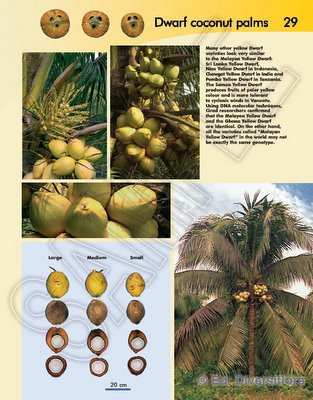 Click on the pictures to enlarge them !
Click on the pictures to enlarge them !From the book:
Coconut. A guide to traditional and improved varieties.
By R. Bourdeix, J.L. Konan and Y.P. N’Cho
Editions Diversiflora, Montpellier, France. Size: 21 x 27 cm - 104 pages
ENGLISH VERSION: ISBN 2-9525408-1-0
FRENCH VERSION: ISBN 2-9525408-0-2
Malayan Yellow Dwarf
The Malayan Yellow Dwarf is probably the most widespread Dwarf coconut in the world. It is thought that Dwarf palms were introduced in Malaysia between 1890-1900 by planters from a place called Kryon or Krion, said to be in Indonesia. The colour of the seedling sprout, the leaf stalk, the inflorescence, and the fruit is pale yellow. When the fruits are younger (6 to 9 months), their colour is often a pale yellow-green.
The palm generally has a thin stem, about 22 to 25 cm in diameter, with no bole. When the growing conditions are excellent, it may have a small bole (35 to 40 cm in diameter). This can be seen in the picture on this page, showing a Malayan Yellow Dwarf planted on the volcanic soil of a Vanuatu island. The youngest leaves at the top of the palm are characterised by the soft petiole terminal portion and soft leaflets. The upper canopy appears like an undressed hair, which can be observed more clearly for the Malayan Yellow Dwarf than for Malayan Red or Green Dwarf. Because of its short peduncle, the bunch is well supported by the leaf petioles.
Malayan Yellow Dwarf has been characterised in the collection of at least ten countries: Brazil, Côte d'Ivoire, Fiji, India, Jamaica Philippines, Tanzania, Thailand, Vanuatu, and Vietnam. The Malayan Yellow Dwarf generally produces medium sized, oblong fruits weighting 700 to 800 g, but the fruit weights may vary a lot. Its mean value range from 370 g (India) up to 1752 g (Vanuatu) according to environmental factors. Inside the fruits, the nuts are almost spherical and generally weight 350 to 450 g. In good field conditions, the Malayan Yellow Dwarf is an early bearer. It starts to flower 2 years after planting and it may produce 80 to 100 fruits per palm per year (at a planting density of 205 palms per hectare and without irrigation). Water from young nuts is sweet, but not as sweet and tasty as some other Green Dwarf cultivars. The albumen is thin and turns into rubbery copra. However, it have a good final oil content of 69%.
the Malayan Yellow Dwarf is sensitive to dry and unfavourable environmental conditions. It is subject to alternate bearing. It is resistant to the Lethal Yellowing Disease (LYD) of Jamaica but susceptible to the LYD found in Tanzania and Ghana. In 2004, Malayan Yellow Dwarf was conserved in the coconut germplasm centres by 28 accessions, with more than 16,000 palms. Malayan Yellow Dwarf can be found at least in the following 15 countries: Benin, Brazil, Côte d'Ivoire, Fiji, India, Indonesia, Jamaica, Mexico, Papua New Guinea, Philippines, Tanzania, Thailand, Vanuatu, Vietnam and Malaysia.
In the field of genetic resources and breeding, the Malayan Yellow Dwarf is the most utilised cultivar worldwide. The COGENT research network recommends to use it systematically as genetic control for field experimentation when comparing Dwarf cultivars. The Malayan Yellow Dwarf is also often chosen for developing new technologies such as vitro-culture of zygotic embryos.
1 comment:
Post a Comment